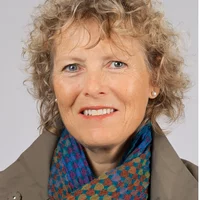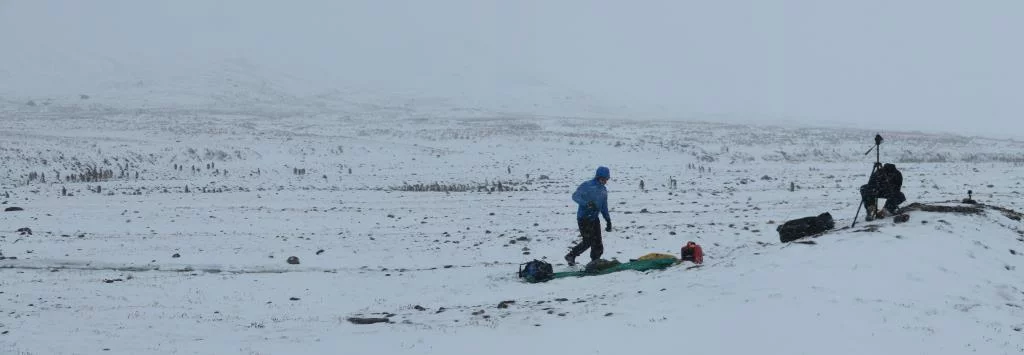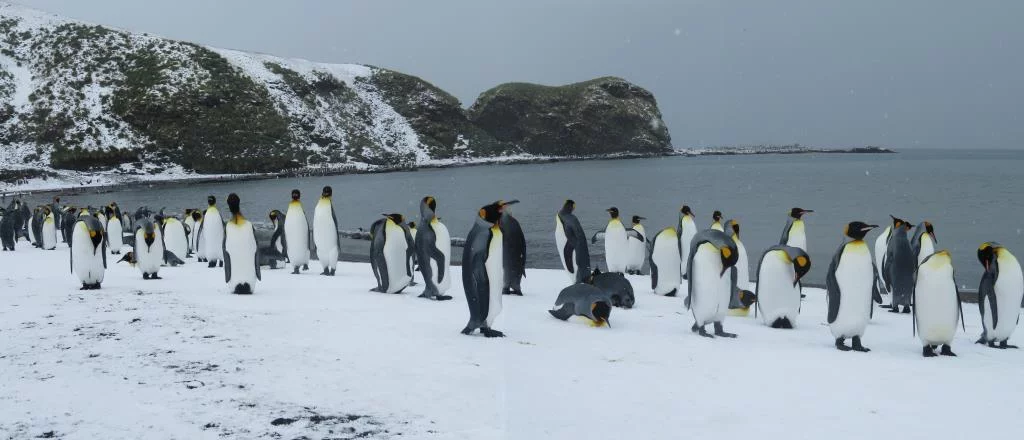Antarctic Blog
6 March 2017
First stop on the last leg: South Georgia
by Julia Schmale
Position 56°55′S 32°24′W
After a short visit in Punta Arenas, Chile, we are back at sea, crossing right away the subpolar front. The sunny and calm days of leg 2 lie behind us, we are back to the raging 50s. One low pressure system is followed by the other, and while we managed to stay between them for the first two days, we get overtaken by the storm behind us as we do our stations at sea. One full station comprises a wide range of activities. First the CTD (conductivity, temperature, depth) on the rosette is launched to 3000 m or deeper to characterize the water mass and take samples at various depths. Then the trace metal rosette is deployed which is essentially the same operation but with a different system that does not contain any metals due to potential contamination. Next comes an instrument which measures the optical properties of the water column at different depths. This information can reveal which microorganisms are present in which abundance at which depth. After that, two types of nets are let into the water to trawl for krill and other animals deep in the sea while the Neuston nets are dragged across a shallow water column to catch phytoplankton specimen. However, on our way to South Georgia, the ocean is unexpectedly unproductive. No phytoplankton specimen are caught by the nets, nor seen in the underway water line, nor is there any DMS dissolved in water, let alone any MSA signature in the aerosol.
In five days we make it to South Georgia. The first item on the list is a visit to King Edwards Points, or Grytviken, the old Norwegian whaling station, where the government of South Georgia has its outpost on the island. A government official visits us on the ship to give a lecture on biosecurity before we are allowed to set foot on the island. Our permits are stamped and then we are ready to go. The weather is unbelievably kind to us. Blue skies, sunshine and only a mild wind make the scenery of the island just wonderful. While all scientists with duties on land go out to sample, the rest of the expedition including the crew members are allowed ashore to visit the whaling station and the museum. Many send postcards from the local post office.
After a day in the Cumberland Bay, we need to move on to St. Andrew’s Bay, where a colony of more than 200.000 pairs of king penguins awaits us. The wind however is so strong on that day that we look for shelter in Stromness, another old whaling station. However, we are unlucky. The wind speed is higher than 100 km/h and the gusts are sometimes twice as strong. The ship is dragged away despite anchoring at the sea floor. There is no option but to sail up and down the coast until the weather permits getting to St. Andrew’s. A day late, we take our chances. The wind has calmed down, but fog and snowfall obscure the skies. Nevertheless, we launch the zodiacs and take off into a grey wall without seeing the coast. The bay however announces itself with the smell and sounds of the penguins. We land amidst the animals. A couple of lazy elephant seals lie around. They hardly bother raising an eyebrow while the fur seal youngsters are eager to pick a fight. They need to practice to defend their territory for the coming years.
Position 56°55′S 32°24′W
After a short visit in Punta Arenas, Chile, we are back at sea, crossing right away the subpolar front. The sunny and calm days of leg 2 lie behind us, we are back to the raging 50s. One low pressure system is followed by the other, and while we managed to stay between them for the first two days, we get overtaken by the storm behind us as we do our stations at sea. One full station comprises a wide range of activities. First the CTD (conductivity, temperature, depth) on the rosette is launched to 3000 m or deeper to characterize the water mass and take samples at various depths. Then the trace metal rosette is deployed which is essentially the same operation but with a different system that does not contain any metals due to potential contamination. Next comes an instrument which measures the optical properties of the water column at different depths. This information can reveal which microorganisms are present in which abundance at which depth. After that, two types of nets are let into the water to trawl for krill and other animals deep in the sea while the Neuston nets are dragged across a shallow water column to catch phytoplankton specimen. However, on our way to South Georgia, the ocean is unexpectedly unproductive. No phytoplankton specimen are caught by the nets, nor seen in the underway water line, nor is there any DMS dissolved in water, let alone any MSA signature in the aerosol.
In five days we make it to South Georgia. The first item on the list is a visit to King Edwards Points, or Grytviken, the old Norwegian whaling station, where the government of South Georgia has its outpost on the island. A government official visits us on the ship to give a lecture on biosecurity before we are allowed to set foot on the island. Our permits are stamped and then we are ready to go. The weather is unbelievably kind to us. Blue skies, sunshine and only a mild wind make the scenery of the island just wonderful. While all scientists with duties on land go out to sample, the rest of the expedition including the crew members are allowed ashore to visit the whaling station and the museum. Many send postcards from the local post office.
After a day in the Cumberland Bay, we need to move on to St. Andrew’s Bay, where a colony of more than 200.000 pairs of king penguins awaits us. The wind however is so strong on that day that we look for shelter in Stromness, another old whaling station. However, we are unlucky. The wind speed is higher than 100 km/h and the gusts are sometimes twice as strong. The ship is dragged away despite anchoring at the sea floor. There is no option but to sail up and down the coast until the weather permits getting to St. Andrew’s. A day late, we take our chances. The wind has calmed down, but fog and snowfall obscure the skies. Nevertheless, we launch the zodiacs and take off into a grey wall without seeing the coast. The bay however announces itself with the smell and sounds of the penguins. We land amidst the animals. A couple of lazy elephant seals lie around. They hardly bother raising an eyebrow while the fur seal youngsters are eager to pick a fight. They need to practice to defend their territory for the coming years.
Time is short for us under these weather conditions and all land parties get on with their work, not paying too much attention to charging seals and lovely penguins. We manage to sample for three hours before the wind is picking up again and we are close to blizzard conditions. At the beach we have a couple of minutes to enjoy the penguins and to take many photographs. Once back on board, we start sailing right away. Another storm is waiting for us. In these conditions with the rainy snowfall, the ammonia plume from the penguin colony unfortunately didn’t make its way out to the ship and so we need to wait for the next chance at the South Sandwich Islands which are due on 7 March.
back to all blog entries
back to all blog entries



